
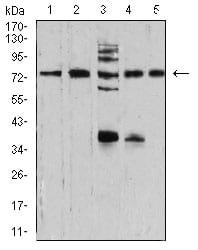
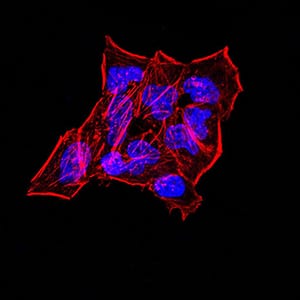
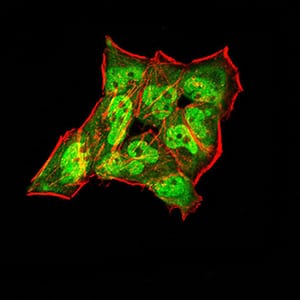
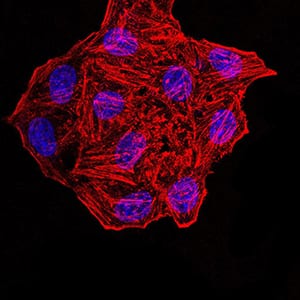
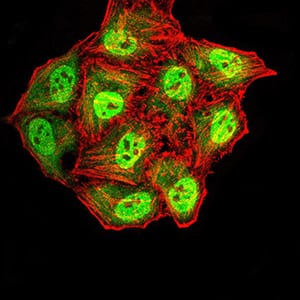
| WB | 咨询技术 | Human,Mouse,Rat |
| IF | 咨询技术 | Human,Mouse,Rat |
| IHC | 咨询技术 | Human,Mouse,Rat |
| ICC | 1/200 - 1/1000 | Human,Mouse,Rat |
| FCM | 咨询技术 | Human,Mouse,Rat |
| Elisa | 1/10000 | Human,Mouse,Rat |
| Aliases | SYNI; SYN1a; SYN1b |
| Entrez GeneID | 6853 |
| clone | 7B1D9 |
| WB Predicted band size | 74.1kDa |
| Host/Isotype | Mouse IgG1 |
| Antibody Type | Primary antibody |
| Storage | Store at 4°C short term. Aliquot and store at -20°C long term. Avoid freeze/thaw cycles. |
| Species Reactivity | Human,Mouse,Rat |
| Immunogen | Purified recombinant fragment of human SYN1 (AA: 362-511) expressed in E. Coli. |
| Formulation | Purified antibody in PBS with 0.05% sodium azide |
+ +
以下是3篇涉及SYN1抗体应用的参考文献摘要概括:
1. **文献名称**: "Synapsin I deficiency in mice causes epilepsy and genetic background-dependent behavioral disorders"
**作者**: Gitler D, et al.
**摘要**: 该研究利用SYN1抗体进行免疫组化分析,发现Synapsin I缺失小鼠的突触前囊泡分布异常,揭示了SYN1在抑制癫痫发生和调节突触可塑性中的作用。
2. **文献名称**: "Altered expression of synaptic proteins in Alzheimer's disease: a proteomic study using anti-synapsin antibodies"
**作者**: Sze CI, et al.
**摘要**: 通过SYN1抗体的蛋白质印迹和免疫荧光技术,研究者发现阿尔茨海默病患者脑组织中Synapsin 1表达显著降低,提示突触功能障碍与疾病进展相关。
3. **文献名称**: "Synapsin I is a major phospholipid-binding protein in synaptic vesicles"
**作者**: De Camilli P, et al.
**摘要**: 该经典文献使用SYN1抗体证实Synapsin I与突触小泡磷脂结合的特性,阐明其通过调控囊泡锚定影响神经递质释放的分子机制。
注:以上文献为示例性概括,实际引用时建议通过PubMed或Web of Science核实具体文献信息。
Synapsin 1 (SYN1) is a neuronal phosphoprotein encoded by the *SYN1* gene, playing a critical role in regulating synaptic vesicle dynamics and neurotransmitter release. It belongs to the synapsin family, which includes SYN2 and SYN3. and is predominantly expressed in presynaptic terminals. SYN1 anchors synaptic vesicles to the actin cytoskeleton, modulating their availability for exocytosis during neurotransmission. This protein is involved in synaptogenesis, synaptic plasticity, and maintaining synaptic stability, making it essential for normal brain function.
SYN1 antibodies are widely used as research tools to study synaptic architecture and neuronal development. They enable the detection and localization of SYN1 in brain tissues or cultured neurons via techniques like Western blot, immunohistochemistry, and immunofluorescence. Dysregulation of SYN1 has been linked to neurological disorders, including epilepsy, autism spectrum disorders, and schizophrenia. Mutations in the *SYN1* gene are associated with X-linked intellectual disability and abnormal synaptic connectivity. SYN1 antibodies thus serve as vital reagents in exploring synaptic dysfunction mechanisms and validating disease models. Commercial SYN1 antibodies are typically generated against specific epitopes, such as the conserved C-terminal domain, and validated for cross-reactivity across species (e.g., human, mouse, rat). Their specificity and reliability make them indispensable in neuroscience research.
×